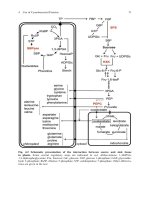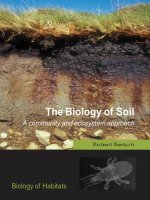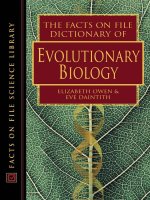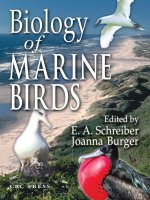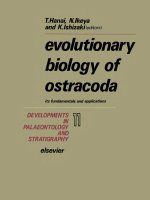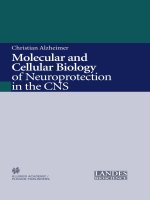evolutionary biology of ostracoda
Bạn đang xem bản rút gọn của tài liệu. Xem và tải ngay bản đầy đủ của tài liệu tại đây (31.98 MB, 1,373 trang )
evolutionary
biology
of
ostracoda
its fundamentak and applications
FURTHER TITLES
IN
THIS SERIES
1.
A.J. Boucot
EVOLUTION AND EXTINCTION RATE CONTROLS
2.
W.A. Berggren and J.A. van Couvering
PALEOCLIMATOLOGY OF THE LAST
15
MILLION YEARS IN MARINE
AND CONTINENTAL SEQUENCES
THE LATE
NEOGENE-BIOSTRATIGRAPHY,
GEOCHRONOLOGY AND
3.
L.J. Salop
PRECAMBRIAN OF THE NORTHERN HEMISPHERE
4.
J.L. Wray
CALCAREOUS ALGAE
5.
A. Hallam (Editor)
PATTERNS
OF
EVOLUTION, AS ILLUSTRATED BY THE FOSSIL RECORD
6.
F.M. Swain (Editor)
STRATIGRAPHIC MICROPALEONTOLOGY OF ATLANTIC BASIN AND
BORDERLANDS
7.
W.C. Mahaney (Editor)
QUATERNARY DATING METHODS
8.
D. Janossy
PLEISTOCENE VERTEBRATE FAUNAS OF HUNGARY
9.
Ch. Pomerol and
I.
Premoli-Silva (Editors)
TERMINAL EOCENE EVENTS
10.
J.C. Briggs
BIOGEOGRAPHY AND PLATE TECTONICS
11.
T. Hanai, N. lkeya and
K.
lshizaki (Editors)
EVOLUTIONARY BIOLOGY OF OSTRACODA, ITS FUNDAMENTALS
AND APPLICATIONS
Developments
in
Palaeontology and Stratigraphy,
1 1
evolutionary
biology
of
I
ostracoda
its
fundamentals and applications
Proceedings
of
the Ninth International Symposium on Ostracoda,
held
in
Shizuoka, Japan,
29
July-2 August
1985
edited
by
Tetsuro Hanai
Professor Emeritus, University of Tokyo, Japan
Noriyuki lke ya
Institute
of
Geosciences, Faculty
of
Science, Shizuoka University. Shizuoka, Japan
and
Kunihiro lshizaki
Institute
of
Geology
and Palaeontologty, Faculty
of
Science,
Tohoku
University, Sendai, Japan
KODANSHA
1988
Tokyo
ELSEVIER
Amste
r
dam-0
xf
o
r
d-
NewYo
r
k-To
ky
o
Copublished by
KODANSHA LTD., Tokyo
and
ELSEVIER SCIENCE PUBLISHERS B.V., Amsterdam
exclusive
sales
rights
in
Japan
KODANSHA LTD.
12-21, Otowa 2chome, Bunkyo-ku, Tokyo 112, Japan
for
the
U.S.A.
and Canada
ELSEVIER SCIENCE PUBLISHING COMPANY, INC.
52 Vanderbilt Avenue, New York, NY
10017
for
the rest
of
the
world
ELSEVIER SCIENCE PUBLISHERS B.V.
25 Sara Burgerhartstraat,
P.O.
Box
21
1,
loo0
AE Amsterdam, The Netherlands
LIBRARY
OF
CONGRESS
Library
of
Congress Cataloging-in-Publication Data
International Symposium on Ostracoda (9th
:
1985
:
Shizuoka-shi,
Evolutionary biology of Ostracoda
:
Its fundanentals and
Japan)
applications
:
proceedings
of
the
Ninth International Symposium on
Ostracoda. held
in
Shizuoka. Japan,
29
July-2 August
1985
/
edited
by Tetsuro Hanai. Noriyuki Ikeya, and Kunihirc Ishizaki.
p. cm.
(Developments in palaeontology and stratigraohy
;
11)
Bibliography:
p.
Includes index.
1.
Ostracoda. Fossil Congresses.
2.
Paleontology Congresses.
ISBN
0-444-98921-8
(U.S.)
3.
Ostracoda Evolution Congresses.
I.
Hanai
,
Tetsuro,
1924-
11. Ikeya, Noriyuki. 111. Ishizaki, Kunihiro. IV. Title.
V. Series.
0~817.08157
1985
565'.33 dc19
88-7122
CIP
ISBN 0-444-98921-8 (V0l.11)
ISBN
0-444-41 142-9
(Series)
ISBN4-06-203039-X
(Japan)
Copyright
0
1988
by
Kodansha Ltd.
All rights reserved.
No part of this book may be reproduced in any form, by photostat, microfilm, retrieval
system, or any other means, without the written permission of Kodansha Ltd. (except in
the case of brief quotation for criticism
or
review).
PRINTED
IN
JAPAN
Contents
Preface
List of Contributors
Participants and Non-attending Members
I.
ADDRESSES
AT
THE
OPENING SESSION
NEALE,
J.
W.
Ostracoda-A historical perspective
HANAI,
T.
A
taxonomist’s view on classification
11.
TAXONOMY
MCKENZIE,
K.
G.
A Recent Dutch microorganism (A. J. Keij), with the description of
HAZEL, J.
E.
and CRONIN, T. M. The North American genus
Climacoidea
Puri,
1956,
MALZ, H. Morphological affinities in Ostracoda, misleading and revealing
MALZ,
H.
and
LORD,
A. Recent ornate bairdiid Ostracoda: Origin and distribution
MALZ,
H.
The
Bairdia
dynasty
review-activities-aspects
NEALE,
J.
W.
and SINGH,
P.
Some problems associated with the genus
Uroleberis
KHOSLA,
S.
C. Tertiary and Recent species of
Miocyprideis
from India
KHOSLA,
S.
C. and NAGORI, M.
L.
The genus
Stigmatocythere
from the Quilon Beds
CHOE, K L.
On
ostracod biofacies and five new genera in Korean seas
OKUBO,
I.
On the Recent
Aurila
species from Japan
LUNDIN,
R.
F.
Function and significance of tubules:
Tubulibairdia
vs.
Microcheilinella
GRAMM, M. N. The free margin contact structures in
some
“palaeocopid” ostracods
Jankeijcythere
new genus (Crustacea, Ostracoda)
and the tribe Campylocytherini (Neogene and Quaternary)
(Lower Miocene) of Kerala, India
and their bearing on classification
xi
xiii
xv
3
17
29
39
57
63
75
81
93
105
121
135
145
159
V
111.
MORPHOLOGY
AND
MORPHOGENESIS
KEYsER,
D.
A.
The origin of the
“Xestoleberis-spot”
MYERS,
J.
H. and KONTROVITZ, M. Geometrical optics of some ostracod eyes
SCHORNIKOV, E.
I.
The concept of cyclicity of morphogenesis
KAESLER,
R.
L.
and
FOSTER,
D.
W. Ontogeny of
Bradleya normani
(Brady):
shape analysis of landmarks
MADDOCKS, R.
F.
Multivariate analysis
of
leg morphology of Macrocyprididae
Hou,
Y T. and ZHAO, Y H.
A
preliminary study on ornamentation and ultrastructure
Som,
I.
G. and KORNICKER, L.
S.
Ultrastructure
of
myodocopid shells (Ostracoda)
JONES,
P.
J. Carapace sculpture in
Amphissites
(Kirkbyacea: Ostracoda)
ADAMCZAK,
F.
J.
of Mesozoic and Cenozoic Ostracoda in China
Evolution of
Amphicostella
from the Middle Devonian in Europe
(Metacopa, Ostracoda)
IV.
BIOLOGY
MOGUILEVSKY,
A.
and WHATLEY,
R.
C. Cytogenetic studies on marine myodocopid
Ostracoda: The karyotypes of
Gigantocypris dracontovalis
Cannon,
1940
and
Macrocypridina casranea
(Brady,
1897)
V.
ECOLOGY
-A,
T. Morphological and ethological adaptations
of
Ostracoda to microhabitats
in
Zostera
beds
IKEYA,
N.
and UEDA, H. Morphological variations of
Cytheromorpha acupunctata
(Brady) in continuous populations at Hamana-ko bay, Japan
CARBONEL,
P.
and T~LDERER-FARMER, M. The ostracod carapace
as
a
hydrochemical
source of information at water/sediment interface
CARBONEL,
P.
and HOIBIAN, T. The impact of organic matter
on
ostracods from
an equatorial deltaic area, the Mahakam delta-southeastern Kalimantan
ABE,
K.
and
CHOE,
K L. Variation
of
Pistocythereis
and
Kegella
species in Gamagyang
Bay, south coast of Korea
BONADUCE,
G.
and DANIELOPOL,
D.
L.
To
see and not to be seen: The evolutionary
problems of the Ostracoda Xestoleberididae
WHATLEW,
R.
C.
and WATSON, K.
A. A
preliminary account of the distribution of
Ostracoda in Recent reef and reef associated environments in the Pulau-Seribu
or
Thousand Island group, Java Sea
177
187
195
207
219
235
243
259
275
293
303
319
34
1
353
367
375
399
Contents
vii
BODERGAT,
A. M. and
IKEYA,
N.
Distribution of Recent Ostracoda in Ise and Mikawa
TABUKI, R. and NOHARA,
T.
Preliminary study on the ecology of ostracods from
429
BENTLEY,
C.
Podocopid ostracods of Brisbane Water, near Sydney, south-eastern Australia 439
BONADUCE,
G., MASOLI, M. and PUGLIESE,
N.
Remarks of the benthic Ostracoda
on the Tunisian Shelf 449
DIAS-BRITO, D., MOURA, J. A. and WORDIG, N. Relationships between ecological models
bays, Pacific coast of central Japan
the moat of a coral reef
off
Sesoko Island, Okinawa, Japan
413
based on ostracods and foraminifers from Sepetiba Bay (Rio de Janeiro, Brazil)
DANIELOPOL, D.
L.,
GEIGER, W., TULDERER-FARMER, M., ORELLANA, C. and TERRAT,
M N.
In
search of
Cypris
and
Cythere-A report of the evolutionary ecological
project on limnic Ostracoda from Mondsee (Austria)
SCHARF,
B.
W. Living ostracods from the nature reserve “Hordter Rheinaue” (Germany)
YANG,
F.
Distribution of the brackish-salt water ostracods in northwestern Qinghai
Plateau and its geological significance
VI.
PALAEOECOLOGY
SIDDIQW, Q. A. The Iperk sequence (Plio-Pleistocene) and its ostracod assemblages in
the eastern Beaufort Sea
PAIK, K H. and LEE, E H. Plio-Pleistocene ostracods from the Sogwipo Formation,
Cheju Island, Korea
HAYASHI, K. Pliocene-Pleistocene palaeoenvironment and fossil ostracod fauna from
the southwestern Hokkaido, Japan
MAYBURY, C. and WHATLEY, R. C. The evolution of high diversity in the ostracod
communities of the Upper Pliocene faunas of St. Erth (Cornwall, England) and
northwest France
STEINECK, P. L., DEHLER, D., HWE, E. M. and MCCALLA, D. Oligocene to Quaternary
SINGH, P. Palaeobiogeography and palaeoecology of the Tertiary ostracods of
ostracods of the central equatorial Pacific (Leg 85, DSDP-IPOD)
northwestern India with palaeooceanographic remarks
record in Texas
MADDOCKS, R.
F.
One hundred million years of predation
on
ostracods: The fossil
ROSENFELD,
A.,
GERRY, E. and HONIGSTEIN, A. Jurassic-Cretaceous non-marine
KAESLER,
R. L. and DENVER, L. E. Distribution and diversity
of
nearshore Ostracoda:
DEWEY, C. P. Lower Carboniferous ostracode assemblages from Nova Scotia
ostracods from Israel and palaeoenvironmental implications
Environmental control in the early Permian
467
485
50
1
519
533
541
557
569
597
619
637
659
671
685
MI.
DEEP
SEA
OSTRACODA
HARTMANN, G.
F.
and HARTMANN-SCHRODER, G. Deep sea Ostracoda, taxonomy,
distribution and morphology
699
NEALE,
J.
W. The anatomy of the ostracod
Pelecocytherepurii
sp. nov. and some features
connected with the abyssal mode of life in this and some other deep water forms
709
VAN
HARTEN, D. and DROSTE, H.
J.
Mediterranean deep-sea ostracods, the species
poorness of the Eastern Basin, as a legacy of an early Holocene anoxic event
WHATLEY,
R.
C. and AYRESP, M. Pandemic and endemic distribution patterns in
72
1
Quaternary deep-sea Ostracoda
739
VIII.
BIOGEOGRAPHY
AND
PALAEOBIOGEOGRAPHY
TITTERTON,
R.
and WHATLEY,
R.
C. The provincial distribution of shallow-water Indo-
HARTMANN, G.
F.
Distribution and dispersal of littoral Pacific Island Ostracoda
Gou,
Y.4.
and CHEN, D Q. On the occurrence of
Javanella
and
Saida
from the
Pliocene of Leizhou Peninsula, Guangdong, China
ZHAO,
Q H. and WANG, P X. Distribution of modern ostracods in the shelf seas
off
China
BABINOT,
J.
F. and COLIN,
J.
P. Palaeogeography of Tethyan Cretaceous marine
ostracods.
DINGLE,
R.
V.
Marine ostracod distributions during the early breakup of southern
Gondwanaland
LORD,
A.
R.
Ostracoda
of
the early Jurassic Tethyan Ocean
Pacific marine Ostracoda: Origins, antiquity, dispersal routes and mechanisms
759
787
797
805
823
841
855
IX.
SPECIATION
CRONIN,
T. M. Geographical isolation in marine species: Evolution and speciation in
IKEYA,
N. and TSUKAGOSHI,
A.
The interspecific relations between three close species
Ostracoda,
I
871
of the genus
Cythere
0.
F.
Muller,
1785
891
ABE,
K.
Speciation completed? in
Keijella bisanensis
species group
919
CRONN,
T.
M.
and
SCHMIDT,
N. Evolution and biogeography
of
Orwnina
in the
DUCASSE,
P.
O.,
Led, C. and ROUSSELLE, L. Polymorphism and speciation: Medoc
Atlantic, Pacific and Caribbean
:
Evolution and speciation in Ostracoda,
I1
927
939
ostracods at the Eocene/Oligocene boundary (Aquitaine, France)
Contents
ix
X.
EVOLUTION
SCHORNIKOV,
E.
I.
The pathways of morphological evolution of Bythocytheridae
KEEN,
M. C. The evolution and distribution of cytherettine ostracods
REYMENT,
R.
A. Evolutionarily significant polymorphism in marine ostracods
95
1
967
987
PEYPOUQUET,
J P., CARBONEL, P., DUCASSE, P.
O.,
T~LDERER-FARMER, M. and LJ~TB, C.
Environmentally cued polymorphism of ostracods-A theoretical and practical
approach. A contribution to geology and to the understanding of ostracod
evolution
1003
1021
WHATLEY,
R. C.
Patterns and rates
of
evolution among Mesozoic Ostracoda
SCHALLREUTER, R.
E.
Homeomorphy, phylogeny and natural classification
:
Case
LUNDIN, R.
F.
Is
Neckajatia
an ancestor of the platycope ostracodes?
studies involving Palaeozoic ostracods
1041
1051
XI.
BIOSTRATIGRAPHY
AND
EXPLORATION
KRSTI~,
N. Some Quaternary ostracods of the Pannonian Basin, with a review
YAJIMA,
M. Preliminary notes on the Japanese Miocene Ostracoda
BONADUCE,
G.,
BISMUTH,
H., RUGGIERI,
G.,
Russo, A. and MASCELLARO, P.
of a few neglectoida
Marine ostracods of the Upper Miocene of the well Ashtart
1
(Gulf of
Gabbs, southeastern Tunisia)
Formation, Laguna Hills, southern California, U.S.A.
FINGER,
K.
L. Depositional paleoecology of Miocene ostracodes in the Monterey
KHALAF,
S.
K.
Middle Miocene Ostracoda from northern Iraq
KIELBOWICZ,
A.
A. Upper Oligocene-Lower Miocene ostracods from the YPF. SCA.
ECa.
X-1
(El Campamento) borehole, Austral Basin, Argentina
GUAN, S Z. Palaeocene non-marine ostracods in China
HE, J D.,
VAN
NIEUWENHUISE,
D.
S.
and SWAIN,
F.
M. Biostratigraphy of Paleogene
HAO, Y C. Cretaceous and Palaeogene ostracod biostratigraphy in Xining and
LI, Y G., Su, D Y. and ZHANG, L J. The Cretaceous ostracod faunas from
non-marine Ostracoda from East China
Minhe Basins of China
the Fuxin Basin, Liaoning Province
1063
1073
1087
1101
1113
1125
1147
1153
1163
1173
ATHERSUCH,
J.
The biostratigraphy of Cretaceous ostracods from Oman
1187
MOURA, J. A. Ostracods from non-marine early Cretaceous sediments of Campos
Basin, Brazil
1207
YE, D Q. Ostracod evolution and depositionid characteristics
of
the Cretaceous
WILKINSON,
I.
P.
Ostracoda across the Albian/Cenomanian (Cretaceous) boundary
LI,
Y W. The application of Ostracoda to location of non-marine Jurassic-Cretaceous
BODERGAT,
A M. and DONZE, P.
CHRISTENSEN,
0.
B. Ostracod zones and dispersion of Mesozoic fossils in the
Xu,
M Y. Ostracods from the Mesozoic coal-bearing strata
of
northern Shaanxi, China
SHI,
C G. and Lr, Z W. Records of the late Carboniferous ostracods from
Nenjiang Formation in Songliao Basin, China
in Cambridgeshire and western Suffolk, eastern England
boundary in Sichuan Basin of China
the Paris Basin (France) by means of ostracod associations
Scandinavian North Sea area
Biostratigraphical scale in the Toarcian of
Jingyuan, Gansu, northwestern China
Genera and Species Index
General and Author Index
1217
1229
1245
1261
1269
1283
1293
1305
1337
Preface
At the general meeting of the Houston symposium, when we proposed to invite the next sym-
posium to Shizuoka, Japan, someone asked
us
about the theme of the upcoming symposium. We
replied that we intended to focus attention on the evolutionary biology of Ostracoda, its funda-
mentals and applications. On second thought, however, we felt that this theme would be inappro-
priate because evolutionary biology is a nomothetic science, whereas the study of Ostracoda adopts
a more or less idiographic approach. Thus it was realized that our intention comprised two general
approaches.
One fundamental approach is expressed in the words “evolutionary biology” and is especially
intended to extend evolutionary biology into the geological past utilising Ostracoda. Taking ad-
vantage of their ideal characteristics for evolutionary research, it is possible
to
determine palaeo-
biologically significant events and develop theories. Recent progress in evolutionary biology seems
to have been mainly based on studies
of experimental organisms suitable for genetic research,
with hardly any fossil evidence. Furthermore, theoretical syntheses in the field of evolutionary
biology have recently advanced rather rapidly without sufficient palaeontological evidence. We
believe that Ostracoda are one of the most useful organisms for studies intended to overcome
difficulties originating from these circumstances. Understanding evolutionary process can doubt-
less be achieved through the cooperation of biologists and palaeontologists. This ostracod research
group, which has been assembling every two or three years since
1963,
is
in a good position to
conduct such studies.
Another traditional approach may be expressed by the two words, “of Ostracoda”. In spite of the
complaints about idiographically oriented methodology, which employs a little classification and
generalizes on the descriptive level, if we trace the history of this methodology back into the time
of Linnaeus and consider that our knowledge of Ostracoda was virtually nil at that time, our
present knowledge is unexpectedly vast in both space and time; it also includes aspects from
many fields of biology and other related sciences, as anyone who has studied Ostracoda knows.
This knowledge of Ostracoda has been strengthened by generalizations on the descriptive level
in the same manner as generalities have known
as
‘laws’ in evolutionary biology. Even if we
defer to the criticism of a strongly idiographic approach, the addition of the words
“of
Ostracoda”
will, at least, still prevent studies from becoming mere intellectual exercises in the nomothetic
and evolutionary disciplines.
Our other aim is to learn of fundamental studies which can be of vital importance, especially for
biostratigraphy and palaeobiogeography, and therefore in the exploration for petroleum resources.
Studies made
by
petroleum palaeontologists may even be able
to
relate evolutionary changes in
ostracod fauna to the temporal influx of sea water flowing into the continents and to the movement
of the plates.
As
this was the first time this symposium was held outside
of
America or Europe, its results
will
xi
xii
PREFACE
aid and influence future ostracod studies in the Asian area. We wish to thank all our contributors
and discussion participants for helping to promote a productive and well attended symposium.
Chinese ostracodologists kindly agreed to receive an excursion to visit fossil localities in China.
For advice, assistance, and help
in
surmounting the language barrier, we are grateful to many
of
our colleagues. Professor John W. Neale and Dr. Heinz Malz prolonged their stays in Japan
and gave us invaluable advice, assistance and support. Dr. J.
F.
Babinot, Dr.
P.
Carbonel, Dr.
Thomas M. Cronin, Dr. P.
0.
Ducasse, Professor Gerhard
F.
Hartmann, Professor Joseph
E.
Hazel, Dr. Yasuaki Ishiwada, Professor Roger
L.
Kaesler, Dr. Takahiro Kamiya, Dr. R.
E. L.
Schallreuter, Dr.
I.
Gregory Sohn, and Dr. Robin
C.
Whatley also gave us valuable advice and
helped us in innumerable ways. We are deeply indebted to all of these people for their unstinting
help and encouragement both during the symposium and in the editing
of
these proceedings.
Tetsuro
HANAI,
Noriyuki
IKEYA
and
Kunihiro
ISHIZAKI
List
of
Contributors
A
Abe, K., Tokyo, Japan
Adamczak, F.J., Stockholm, Sweden
275
Athersuch,
J.,
Sunbury, England, U.K.
1187
Ayress, M., Aberystwyth, Wales, U.K.
367, 919
739
B
Babinot, J.F., Marseille, France
823
Bentley, C., Canberra, Australia
439
Bismuth, H., Tunis-Belvedtke, Tunisia
1087,
Bodergat, A M., Villeurbanne, France
413
Bonaduce, G., Naples, Italy
375, 449, 1087
1261
C
Carbonel, P., Talence, France
Chen, D Q., Nanjing, P.R. China
Choe, K L., Seoul Korea
Christensen, O.B., Stavanger, Norway
1269
Colin,
J P.
Bkgles, France
823
Cronin,
T.M., Reston, Virginia, U.S.A.
39,
341, 353, 1003
797
121, 367
871, 927
D
Danielopol, D.L., Mondsee, Austria
Dehler, D., Purchase, New York, U.S.A.
Denver, L.E., Lawrence, Kansas, U.S.A.
Dewey, C.P., Mississippi, USA.
685
Dias-Brito, D.,
Rio
de Janeiro, Brazil
Dingle, R.V., Cape Town, South Africa
Donze, P., Villeurbanne, France
1261
Droste, H.J., Amsterdam, Netherlands
721
Ducasse, P.O., Talence, France
939, 1003
375, 485
597
671
467
841
F,
G
Farmer,
M., Talence, France
1003
Finger, K.L., LaHabra, California, U.S.A.
1101
Foster, D.W., Lawrence, Kansas, U.S.A.
207
Geiger, W., Mondsee, Austria
485
Gerry,
E.,
Ramataviv, Israel
659
Gou, Y S. Nanjing, P.R. China
Gramm, M.N., Vladivostok, U.S.S.R.
159
Guan,
S Z.
Beijing, P.R. China
797
1147
H
Hanai, T., Tokyo, Japan
17
Hao, Y C., Beijing, P.R. China
Hartmann, G.F., Hamburg, F.R.G.
Hartmann-Schroder, G., Hamburg, F.R.G.
699
Hayashi, K., Tokyo, Japan
557
Hazel, J.E., Baton Rouge, Louisiana, U.S.A.
39
He, J D., Nanjing, P.R. China
1153
Hoibian, T., Talence, France
353
Honigstein, A., Tel-Aviv, Israel
659
Hoose, E.M., Purchase, New York, U.S.A.
Hou, Y T., Nanjing, P.R. China
235
1163
699, 787
597
1,
J
Ikeya, N., Shizuoka, Japan
319, 413, 891
Jones, P.J., Canberra, Australia
259
K
Kaesler, R.L., Lawrence, Kansas, U.S.A.
Kamiya,
T.,
Kanazawa, Japan
303
Keen, M.C., Glasgow, Scotland, U.K.
Keyser, D.A., Hamburg, F.R.G.
177
Khalaf, S.K., Mosul, Iraq
1113
Khosla, S.C., Udaipur, India
93,
105
Kielbowicz, A.A., Florencio Varela,
Argentina
Kontrovitz,
M.,
Monroe, Louisiana, U.S.A.
Kornicker, L.S., Washington, D.C., USA.
207,
671
967
1125
187
243
xiii
xiv
LIST
OF
CONTRIBUTORS
KrstiE, N., Beograd, Yugoslavia
1063
L
Lee, E H., Seoul, Korea
541
Lktk, C., Talence, France
939, 1003
Li, Y G., Beijing, P.R. China
1173
Li, Y W., Chengdu, P.R. China
Li, Z W., Gansu, P.R. China
1293
Lord, A.R., London, England, U.K.
Lundin, R.F., Tempe, Arizona, U.S.A.
145,
1245
63, 855
1051
M
Maddocks, R.F., Houston, Texas, U.S.A.
Malz, H., Frankfurt
am
Main, F.R.G.
Mascellaro, P., Naples, Italy
1087
Masoli, M., Trieste, Italy
449
Maybury, C., Aberystwyth, Wales, U.K.,
McCalla, D., Purchase, New York, U.S.A.
McKenzie, K.G., Wagga Wagga, Australia
Moguilevsky, A., Aberystwyth, Wales, U.K.
Moura, J.A., Rio de Janeiro, Brazil
Myers, J.H., Monroe, Louisiana, USA.
219,
57, 63,
637
75
569
597
29
293
467, 1207
187
N
Nagori, M.L., Udaipur, India
105
Neale, J.W., Hull, England,
U.K.
Nohara, T., Okinawa, Japan
429
3,
81, 709
Okubo,
I.,
Okayama, Japan
135
Orellana,
C.,
Mondsee, Austria
485
Paik, K H., Seoul, Korea
541
Peypouquet, J P., Talence, France
1003
Pugliese, N., Trieste, Italy
449
R
Reyment, R. A., Uppsala, Sweden
Rosenfeld, A., Jerusalem, Israel
659
Rousselle,
L.,
Talence, France
939
Ruggieri,
G.,
Palermo, Italy
1087
RUSSO,
A.,
Modena, Italy
1087
987
S
Schallreuter, R.E.L., Hamburg, F.R.G.
1041
Scharf, B.W., Mainz, F.R.G.
501
Schmidt, N., Tucson, Arizona, U.S.A.
Schornikov, E.I., Vladivostok, U.S.S.R.
195,
Shi, C G., Nanjing, P.R. China
1293
Siddiqui, Q.A., Halifax, Canada
533
Singh, P., Dehra Dun, India
81,
619
Sohn, I.G., Washington, D.C., U.S.A.
Steineck, P.L., Purchase, New York, U.S.A.
Su,
D Y., Bei.jing, P.R. China
1173
Swain, F.M., Newark, Delaware, U.S.A.
927
95
1
243
597
1153
T
Tabuki, R., Okinawa, Japan
429
Terrat, M N., Metz, France
485
Titterton, R., Gwynedd, Wake, U.K.
759
Tolderer-Farmer, M., Talence, France
341
Tsukagoshi,
A.,
Shizuoka, Japan
891
Ueda, H., Shizuoka, Japan
319
Van Harten, D., Amsterdam, Netherlands
Van Nieuwenhuise, D.S., Tulsa, Oklahoma, U.S.A.
721
1153
W
Wang, P X., Shanghai, P.R. China
Watson,
K.,
Aberystwyth, Wales, U.K.
399
Whatley, R.C., Aberystwyth, Wales,
U.K.
Wilkinson, I.P., Keyworth, England, U.K.
Wurdig, N., Port0 Alegre, Brazil
805
293,
1229
399, 569, 739, 759, 1021
467
Xu,
M Y. Xian, P.R. China
1283
Yajima, M., Tokyo, Japan
1073
Yang,
F.,
Beijing, P.R. China
Ye, D Q., Daqing, P.R. China
1217
519
Zhang, L J., Shenyang, P.R. China
1173
Zhao, Y H., Nanjing, P.R. China
Zhao, Q H., Shanghai, P.R. China
235
805
Participants
A
Abe, K., Tokyo, Japan
Adachi,
S.,
Tsukuba, Japan
Adamczak,
F.
J., Stockholm, Sweden
Al-Furaih, Ali A. F., Riyadh, Saudi Arabia
Athersuch, J., Sunbury, England, U.K.
B
Bentley, C. J., Canberra, Australia
Berdan,
J.
M., Washington, D.C., U.S.A.
Bismuth, H., Tunis-Belv&l&re, Tunisia
Bodergat, A M., Villeurbanne, France
Bonaduce, G., Naples, Italy
C
Chinzei, K., Kyoto, Japan
Choe, K L., Seoul, Korea
Christensen,
0.
B.,
Stavanger, Norway
Cohen, A. C.,
Los
Angeles, U.S.A.
Colin, J P.,
Bkgles,
France
Colizza, E., Trieste, Italy
Copeland, M. J., Ottawa, Canada
Cronin, T. M., Reston, Virginia, U.S.A.
D
De Deckker, P., Clayton, Australia
Dias-Brito, D., Riode Janeiro, Brazil
Dingle, R. V., Cape Town, South Africa
Frydl,
P. M., Calgary, Canada
GOU, Y S., Nanjing, P.R. China
Groos-Uffenorde, H., Gottingen, F.R.G.
H
Hall, S.J., Sydney, Australia
Han, D X., Beijing, P.R. China
Hanai, T., Tokyo, Japan
Hao, Y C., Beijing, P.R. China
Hartmann, G. F., Hamburg, F.R.G.
Hatanaka,
M.,
Tokyo, Japan
Hayami, I., Tokyo, Japan
Hayashi, K., Tokyo, Japan
Hazel, J.E., Baton Rouge, Louisiana, U.S.A.
Hiruta,
S.,
Kushiro, Japan
Honigstein, A.C., Tel-Aviv, Israel
Hou, Y T., Nanjing, P.R. China
I
Ikeya, N., Shizuoka, Japan
Inoue, H., Tokyo, Japan
Ishizaki, K., Sendai, Japan
Iwasaki, Y., Kumamoto, Japan
K
Kaesler, R.L., Lawrence, Kansas, U.S.A.
Kamiya, T., Kanazawa, Japan
Keen, M.C., Glasgow, Scotland, U.K.
Keyser, D.A., Hamburg, F.R.G.
Khosla, S.C., Udaipur, India
Kitazato, H., Shizuoka, Japan
Kontorovitz, M., Monroe, Louisiana, U.S.A.
Koshikawa, K., Tokyo, Japan
KrstiC, N., Beograd, Yugoslavia
L
Lee,
E H., Seoul, Korea
Li, Y G., Beijing, P.R. China
Li, Y W., Chengdu, P.R. China
Lord, A.R., London, England, U.K.
Lundin, R.F., Tempe,
Arizona,
U.S.A.
M
Maddocks, R.F., Houston, Texas, U.S.A.
xvi
PARTIUPANIS
AND
NON
Ane"o
MEMLBERS
Malz, H., Frankfurt am Main, F.R.G.
Maybury, C.A., Aberystwyth, Wales, U.K.
Mckenzie, K.G., Wagga Wagga, Australia
Moriya,
S.,
Tokyo, Japan
Moura, J.A.,
Rio
de Janeiro, Brazil
N,
0
Neale, J.W., Hull, England, U.K.
Nohara, T., Okinawa, Japan
Oertli, H. J., Pau, France
Oji, T., Tokyo, Japan
Okada, H., Shizuoka, Japan
Okubo,
I., Okayama, Japan
p,
R
Pa&, K H., Seoul, Korea
Peypouquet,
J P.,
Talence, France
Pugliese, N., Trieste, Italy
Reyment, R.A., Uppsala, Sweden
Rosenfeld, A., Jersalem, Israel
S
Sato, T., Tokyo, Japan
Schallreuter, R.E.L., Hamburg, F.R.G.
Scharf, B.W., Maim, F.R.G.
Schmidt, N.J., Tucson, Arizona, U.S. A.
Schweitzer, P.N., Woods Hole, U.S.A.
Shi,
C G., Nanjing, P.R. China
Siddiqui, Q.A., Halifax, Canada
Al-Abdul-Razzaq, S.K., Kuwait, Kuwait
Blom, W., Sydney, Australia
Carbonel, P., Talence, France
Carbonnel, G., Villeurbanne, France
Danielopol, D.L., Mondsee, Austria
Decrouez, D., Geneva, Switzerland
Dewey, C.P., Mississippi, U.S.A.
Singh, P., Dehra Dun, India
Siveter, D.
J.,
Leicester, England, U.K.
Sohn, I.G., Washington, D.C., U.S.A.
Steineck, P.L., Purchase, New York, U.S.A.
T
Tabuki, R., Okinawa, Japan
Tambareau, Y.J., Toulouse, France
Titterton, R., Gwynedd, Wales, U.K.
Tohbaru,
M.,
Okinawa, Japan
Tsukagoshi, A., Shizuoka, Japan
u,
v
Ueda, H., Shizuoka, Japan
Van Harten, D., Amsterdam, Netherlands
Van Nieuwenhuise, D.S., Tulsa, Oklahoma, U.S. A.
W
Wang, P X., Shanghai, P.R. China
Watson, K.A., Aberystwyth, Wales, U.K.
Weitschat, W.U., Hamburg, F.R.G.
Whatley, R.C., Aberystwyth, Wales, U.K.
Wilkinson, I.P., Keyworth, England, U.K.
x,
y
Xu, M Y., Xian, P.R. China
Yajiam, M., Tokyo, Japan
Yamaguchi,
T.,
Chiba, Japan
Yang, F., Beijing, P.R. China
Ye, D Q., Daqing, P.R. China
Non-Attending
Members
Ducasse, P.O., Talence, France
Finger, K.L.,
La
Habra, California, U.S.A.
Haskins, C. W., Gwynedd, Wales, U.K.
Ishiwada, Y., Tokyo, Japan
Jones, P.J., Canberra, Australia
Kielbowicz, A.A., Florencio Varela, Argentina
I
Addresses at
the
General
Assembly
This Page Intentionally Left Blank
Ostracoda-
A
Historical Perspective
JOHN
W.
NEALE
University
of
Hull,
England
The Organising Committee of the Ninth International Symposium greatly honoured me by
their kind invitation to give this Keynote Address. At the same time they presented me with
a
considerable problem. In his Keynote Lecture to the Eighth Symposium at Houston, Professor
Kesling not only said most of what
I
wanted to say, but said it with considerable elegance and
wit. In looking for a different approach
I
thought that it might be useful to consider our field of
study in its historical context, and in
so
doing perhaps assist new workers entering the field by
drawing attention to some of the more interesting and useful papers that can be read with profit.
A
necessarily brief review of this sort immediately introduces a great element of selectivity, some
would say bias. Thus, at the outset, let me say that in the following remarks
I
shall make no re-
ference to that large group of ostracods the Myodocopida nor to the eminent zoologists who
worked on them. At the same time I am sure that colleagues working in the Palaeozoic will also
feel that their special interests are under-represented. Nevertheless,
I
hope that at the end we shall
have achieved a broad, and not too distorted, overview of where we and our subject stand as we
start our more detailed deliberations.
In the current issue of ‘Cypris’ we are invited to contemplate a piece of Pueblo pottery dating
back to about
A.D.
1000
-1
150 in which the Mogollon people of New Mexico used what appear
to be undoubted ostracods in one of their decorative designs. The figures have even been tentatively
named as
Chlamydotheca
or
Megalocypris!
In 1746 Linnaeus described an ostracod but our start-
ing point may be taken as 1753 when Mr. Henry Baker published his “Employment for the Micro-
scope” as a supplement to his “Microscope Made Easy” of 1742. Here, 232 years ago, what appears
to be a species of
Cypris
was both figured and described.
We may ponder that in that same year King George
I1
sat on the throne of England and Sir
Hans Sloane founded the British Museum. In Japan the Shogun Tokugawa Ieshige held sway,
while in China the Manchu Dynasty was paramount with the Ch’ien Lung Reign of Kao Tsung.
Louis XV occupied the throne of France, whilst in America a young English surveyor by name
of George Washington was sent by the Governor of Virginia to Fort Le Boeuf to ask these same
French
to
withdraw from Ohio.
Progress in the early days was slow and dominated by Taxonomy, that discipline which must
precede all other work in the field of Natural History.
TAXONOMY
The start of Linnean taxonomy in our group may be taken as 1776 when the Danish worker
Otto Friedrich Muller established the genus
Cypris,
to be followed by his
Cythere
in 1785. Appro-
priately enough in its bicentenary year, the latter is the subject of a paper to be given by Ikeya and
3
4
J.
W.
NEALE
Malz later in this Symposium. The next significant date is 1806, ingrained in our minds from writing
“Subclass Ostracoda Latreille 1806”. Pierre Andre Latreille (1 762-1 833) was a Frenchman who
was known to the early 19th Century as the “Prince of Entomology”. Oertli (1983) tells the fas-
cinating story of how Latreille was sentenced to deportation in 1795 after the French Revolution
on account of his religious education. The discovery of a new species of beetle in his cell which
was drawn to the attention of Bory de Saint-Vincent saved his life and thus kept his name per-
petually before us. Another Frenchman, Anselme Gaetan Desmarest
(1
784-1 838) has the honour
of describing the first fossil ostracod,
Cypris
fuba, collected from the Oligocene between Vichy and
Cusset at La Balme d’Allier. He may justly be claimed as the “Father of Ostracod Micropalaeon-
tology”. Thereafter, progress in the field of both Recent and fossil taxonomy was swift. The early
part of the nineteenth century was dominated by such figures as Strauss, Jurine, Roemer and Reuss,
followed a little later by Cornuel and Bosquet
to
name but a few. In Britain it was fossil forms
that first received monographic treatment, T.R.Jones’ Cretaceous work of 1849 preceding Baird’s
Recent monograph by just one year. During the second half
of
the century, work on fossil ostracods
continued with people like Chapman, Seguenza and Terquem, and Recent freshwater forms were
well served by Moniez, Vavra and others. Work on Recent marine forms occupied a dominant
position, however, and received attention from five of the best known ostracod workers. In Britain
David Robertson (1806-1896), The Reverend A.M.Norman (1831-1918) and G.S.Brady (1832-
1921) produced
a
whole series of papers and monographs which are familiar to most of us. In
Norway G.O.Sars
(1
837-1927) working in Bergen established the categories “Myodocopa, Clado-
copa, Podocopa and Platycopa” as early as 1866, while in Germany G.W.Muller is particularly
remembered for his great work on the Gulf of Naples Fauna of 1894. The beginning of the twen-
tieth century was marked by something of a pause until the late 1920’s and 1930’s saw a great
expansion of interest as the pace of oil exploration quickened, with increasing attention paid to
ostracods in America and Germany.
In the first half of this century one of the main pre-occupations was the recognition of the pro-
blem of juvenile moulk and sexual dimorphism in taxonomy. By the mid-1950’s the general
awareness of this problem meant that it no longer dominated the thoughts of taxonomists to quite
the same extent.
In the taxonomy of any group there is a primary analytical phase mainly concerned with the
description of new species, followed by
a
phase of synthesis when the knowledge gained is collated
and ordered in various ways. In ostracods the analytical phase has lasted well over
200 years and
is still very much with us. We are still only at the outset of the phase of synthesis which will gather
momentum in the coming years. At this stage it is useful to look more closely at taxonomy from
the point of view of some of the problems involved.
In the establishment of any species there are three mandatory requirements namely 1, Illustration
2, Diagnosis and
3,
Description (to some extent now becoming superfluous). To this one may add
a fourth which is not mandatory but which is perhaps second only to illustration in usefulness,
namely
a
discussion of affinities and differences. If we now look
at
problems which arise in tax-
onomy we may list them broadly under three headings.
Illustration
This has been the cause of numerous problems of interpretation. From earliest times until the
present day illustration has been by means of shaded drawings and line diagrams, exclusively
so
until the beginning of this century. These have varied from the very good to the very bad. The
“very bad”, the cause of many of our problems, we need mention no further but superb examples
of the shaded drawing at its best may be seen in Brady’s “Challenger” Monograph of 1880 and
Muller’s “Gulf of Naples’’ Monograph of 1894 to name but two among many. This tradition is
Historical Perspective
5
continued by a number of living workers at the present day and one may perhaps pay tribute here
to the standard of line drawing set by C.W.Wagner in his 1957 work on the Pleistocene which has
rarely been equalled for clarity in showing the essential internal features
of
the shell. The con-
ventions employed in the shaded, three-dimensional drawings are legion and would make an intere-
sting thesis.
Optical photography came late on the scene and only really developed in the 1930’s. Its basic
drawback was the problem of overcoming the inherent incompatibility between resolution and
depth of focus consequent on the material whose size falls just between the availability of two
different photographic techniques. The one master in this field of optical photography was Eric
Triebel(l894-1971) who worked in the Senckenberg Museum in Frankfurt. His daughter regularly
demonstrated to visitors the ease and simplicity of the technique but few could equal the quality
of his pictures. The literature contains many examples of papers published with illustrations
SO
poor as to be completely useless.
This inter-regnum of some forty years ended with the development of the electron scanning
microscope in the late 1960’s. Peter Sylvester-Bradley (1913-1978) was the first to realise its full
significance and potential and as a result founded the Stereo-Atlas of Ostracod Shells. This
development of three-dimensional representation by means of stereo-pair photographs has re-
volutionised taxonomy. The fact that the photograph is often better and shows more than the
actual specimen under the light microscope has cut down the need to visit collections or borrow
specimens to a large extent. It has also rendered the need for pedestrian description in establishing
taxa largely superfluous. Alas authors can still be badly served by the printer who has it in his
power to ruin even the most perfect of original photographs. Generally, however, illustration
is no longer a problem.
Variation,
Moulting
and
Sex
now assumed a greater importance.
The taxonomic problems caused by these have been noted already and other problems have
Present Problems
2,
The Taxonomic Explosion and 3, Data Handling.
At the present day problems arise in three main areas. These may be listed as 1, Communication;
Communication
Rapid dissemination of information and results has always been an important requisite in
Science, and even more
so
with the current spate of papers appearing daily. The solution to this
has been two-fold. Firstly, with great prescience Harbans Puri, helped by Gioacchino Bonaduce
arranged the First International Ostracod Symposium in Naples in 1963 attended by twenty-
three ostracodologists. This provided a valuable forum for the interchange of ideas and a catalyst
for work in this field. Many valuable taxonomic papers have resulted and one may instance the
detailed analysis of the furcal attachment and its use in the taxonomy of freshwater ostracods by
Dom Rome (1893-1974) presented to the Second Symposium held in Hull in 1967. These Symposia
have proved their worth and have been held at intervals ever since,
so
that we now find ourselves
attending the Ninth.
The Naples Symposium also set up the second branch of communication in establishing an
ostracod newsletter “The Ostracodologist” which Ephraim Gerry produced single handed for
nearly twenty years. Now that “The Ostracodologist” has evolved into “Cypris” it is fitting to
pause and remember the very great debt that we owe to Ephraim Gerry’s dedication.
6
J.
W.
NEALE
The
Taxonomic Explosion
In many ways this is the most worrying and intractable problem for new taxa have been appear-
ing at an accelerating rate over the last twenty years. The task of keeping up with an ever increas-
ing and widely spread literature is daunting. There are a number of ways in which some amelio-
ration is possible and which help in the task of synthesis and simplification.
Keys
The production of a key to genera and species is one of the standard approaches of the biologist
and can be strongly recommended as a discipline to clarify the mind for palaeontologists as well.
The development of a good and usable key is a surprisingly difficult exercise. Personal experience
of keys suggests that they often fail at the critical moment.
It
is no use referring to structures
found only in males
if
you have no males among your specimens!
The Greater Use
of
Subgenus and Tribe
These can make an appreciable contribution to the simplification of what is rapidly becoming
an unmanageable output of new names. They have been used to great effect by a number of
our
most active taxonomists and it is
a
source of concern that the current Treatise of Invertebrate
Paleontology Committee has apparently decided that the Tribe, an accepted taxonomic category,
shall not be used. It is
to
be hoped that the Committee will have second thoughts on this and leave
such matters to the taxonomic judgement of the authors concerned.
Check Lists
The development of Check Lists over the last fifteen years has provided a most useful aid in
coping with the enormous increase in taxonomic output. They cover many areas including South
Africa (McKenzie, 1971), India and Ceylon (McKenzie, 1972), Japan (Hanai
et
al.,
1977), Australia
and Papua (De Deckker and Jones, 1978) and South East Asia (Hanai, Ikeya and Yajima, 1980).
Very much more than Check Lists, but
of
great value as such, are the detailed faunal studies of
certain regions such as those of Hartmann (1962 and others) on the Chilean Coast, and the
coasts of West Africa, Australia and elsewhere.
Taxonomic Handbooks
An important source of reference, these represent a synthesis of information as known at the
time of publication. Modern works started essentially in 1952 with the ongoing Ellis and Messina
“Catalogue of Ostracoda”, Howe’s “Handbook
of
Ostracod Taxonomy”
(1
955) and Grekoffs
“Guide Pratique” (1956). Since then we have had Pokorn$’s Grundzuge der Zoologischen
Micro-
palaontologie (1939, the Russian (1960) and Anglo-American (1961) Treatises, Van Morkhoven’s
two-volume work (1962/3) and Hartmann (1963, 1968). Since then the most significant work has
been the Classification of Hartmann and Puri (1974). With the growth in taxa in the last twenty
years a revised Treatise is long overdue. It will, however, need to be a very different work from
its predecessors. An old drawing or figure of the holotype is no longer sufficient. A good S.E.M.
photograph (preferably stereoscopic) is essential, and failing the holotype, figures of a lectotype
or at very least topotype material of each genus is needed coupled with a unique diagnosis.
A
counsel of perfection would include also a note on affinities and differences and
a
key.
Data Handling
This has received increasing attention over the last ten years.
Data Bases
All taxonomists maintain some sort of data base. One of the earliest, most comprehensive and
best known is that established by Henry van Wagenen Howe (1896-1973) at the Louisiana State
University, Baton Rouge. In the past such data bases have tended to become
so
burdensome,
or
required such a disproportionate amount of time to maintain, as to leave little
or
no time for
research. The advent of the easily available computer has altered all that and given exciting pos-
Historical Perspective
7
sibilities for the interchange of data on disc and tape as well as by print out. The Cologne Index
of non-marine ostracods produced by Kempf in 1980 and now being expanded to include marine
ostracods is a case in point. There is no doubt that this area will continue to develop and grow
during the next few decades.
Computerised Recognition
of
Taxa.
A taxonomist’s dream, this seems unlikely to
be
realised even though work on computerised
recognition of pollen grains is well advanced in my own University. Ostracods would seem
to
present too many variables in the form of growth stages, sexual dimorphism and phenotypic
variation to make such a development possible. History, however, has a long record of over-
turning statements such as this and in future such pessimistic views may well be proved wrong to
our great and lasting benefit.
Taxonomy continues to be the basic foundation of ostracod studies. It took a century before
a second strand became firmly established.
BIOSTRATIGRAPHY
Work on fossil ostracods gathered pace in the first half of the nineteenth century but their use
in biostratigraphy was overshadowed by other groups. It is no surprise that their first useful
application was in the non-marine Mesozoic rocks. The English Purbeck and Wealden deposits
contain many biostratigraphically unrewarding materials such as plant remains, insects, dinosaur,
turtle and crocodile bones and non-marine Mollusca, but ostracods (especially the genus
Cyprideu)
often turn up in great abundance on the bedding planes. Recognition of their biostratigraphical
value was due to Edward Forbes (1815-1854) although his views were expressed in only two short
papers. It was left to
T.
Rupert Jones in the second half of the nineteenth century to augment
Forbes’ work and produce the zonal system, later refined by F.W.Anderson (1905-1982) and
P.C.
Sylvester-Bradley (191 3-1 978), which now forms the standard for correlation of these non-marine
deposits throughout Western Europe. In the last thirty years similar work by Krommelbein (1920-
1982) and others has provided a standard for South American and West African non-marine
Mesozoic rocks.
Marine biostratigraphy, as distinct from description of faunas, has been largely a twentieth
century phenomenon. Techniques are standard and results have been mixed. Many local schemes
exist but ostracods are very dependent on their environment and wide-ranging zonal indices still elude
us. Perhaps the most interesting development in this area has been the attempt by Sissingh (1976)
to
correlate late Tertiary deposits from different environments in the Mediterranean and Aegean
areas. With this growth of taxonomic and biostratigraphical work there came a growing awareness
of ecological controls and the development of work in this field which we may look look at next.
ECOLOGY
Ecology covers a wide range of topics. The early workers were well aware of the principal con-
trols such as salinity and temperature although their primary concern was with taxonomy and
related matters. Predation by ostracods was recognised as early as 1821 when Strauss described
Cypris
feeding on carrion. Over a century later this topic caused considerable interest when Des-
chiens, Lamy and Lamy (1953) described
Cypridopsis hartwigi
Miiller from Africa feeding on the
snails which form one of the vectors in the transmission of the disease bilharziasis. Unfortunately
the value of this ostracod as a potential biological control has never been proved and even
so
8
J.
W.
NEALE
its use would probably be impracticable.
Ostracods as victims of predators are much better known. At the turn of the century Scott was
investigating the numbers and taxonomy of ostracods eaten by fish for the Fisheries Board of
Scotland. They are also known to be eaten by a wide variety of other organisms such as ragworms,
echinoids, gastropods and amphibians. There is even a record from the Trias of India of freshwater
ostracods ingested, apparently accidently, by what is thought to have been
a
rhynchosaur whilst
munching vegetation. It was Rees (1940), however, who demonstrated
a
relationship between the
size of ostracod population, presence of ragworms, nature of the substrate and availability of
food supply on
a
mud flat in the Severn Estuary and
so
linked together
a
number of different
factors affecting the population. The varying distribution of juveniles and adults and of the dif-
ferent sexes has also elicited a considerable literature and the idea of seasonal migration was in-
troduced by Tressler and Smith (1948).
Colour in ostracods is a neglected subject.
H.
Munro Fox, author of the standard work on co-
lour in animals, only took up ostracod research in the last ten years of his life after retirement.
During this period he made no particular contribution on colour in ostracods. Yet some fresh-
water species show brilliant purple and orange markings, or are suffused with deep green or sepia
hues and patterns and the subject may be well worth exploring.
Strandesia sexpunctata
from South
East Asia has three bright violet, perfectly circular spots on each valve which perhaps suggests
the eyes of a much larger animal and thus acts as
a
defence mechanism to deter would be predators.
Function in these matters, however, is always difficult to determine with any certainty.
A
whole
range
of
other factors is relevant to ecological studies as an acquaintance with the literature will
confirm. Ecological studies, as distinct from works containing ecological comments incidental
to other studies, may perhaps be said to start with Elofson’s study of the ostracods of the Skagerrak
(1941) in which he gives information on temperature, salinity and substrate and makes some at-
tempt to relate the nature of the shell form to the substrate. With the intervention
of
the war,
ecological studies were slow to develop and the next major study was that by Swain on San An-
tonio Bay, Texas (1955) since when
a
whole range
of
studies in varying detail has covered many
parts of the world.
PALAEOECOLOGY
With the interest and value of modern ecological studies firmly established, work
on
fossil faunas
soon followed. As the modern starting point one may single out C.W. Wagner’s work on the Qua-
ternary of the Netherlands (1 957). Here, by applying information gained from living representa-
tives of the same taxa, he was able to reconstruct the old Pleistocene environments. Many palaeo-
ecological studies have appeared since then, often concerned with particular aspects of the environ-
ment. Deductions regarding salinity have been based on extrapolation back from modern taxa
or on associations, but one aspect of salinity studies deserves further mention. Salinity and its
effect on the development of nodes on the shell (almost synonymous with studies on the genus
Cyprideis)
has produced a whole literature of its own as the arguments have raged between the
proponents of genotypy, phenotypy, polyploidy and the like. From many papers one may single
out for reference Sandberg’s work on
Cyprideis
in the Americas (1964) and Kilenyi’s paper dealing
with transient and balanced genetic polymorphism as an explanation of variable noding (1 972).
Bibliographies in these papers will provide anyone interested with plenty of further reading.
Temperature has been covered many times in Quaternary and Tertiary studies but an interesting
use of Uniformitarianism can take us as far back as the Cretaceous. There are no species in common
with the present and few genera either, but the present day platycopids
Cytherella
and
Cytherel-
